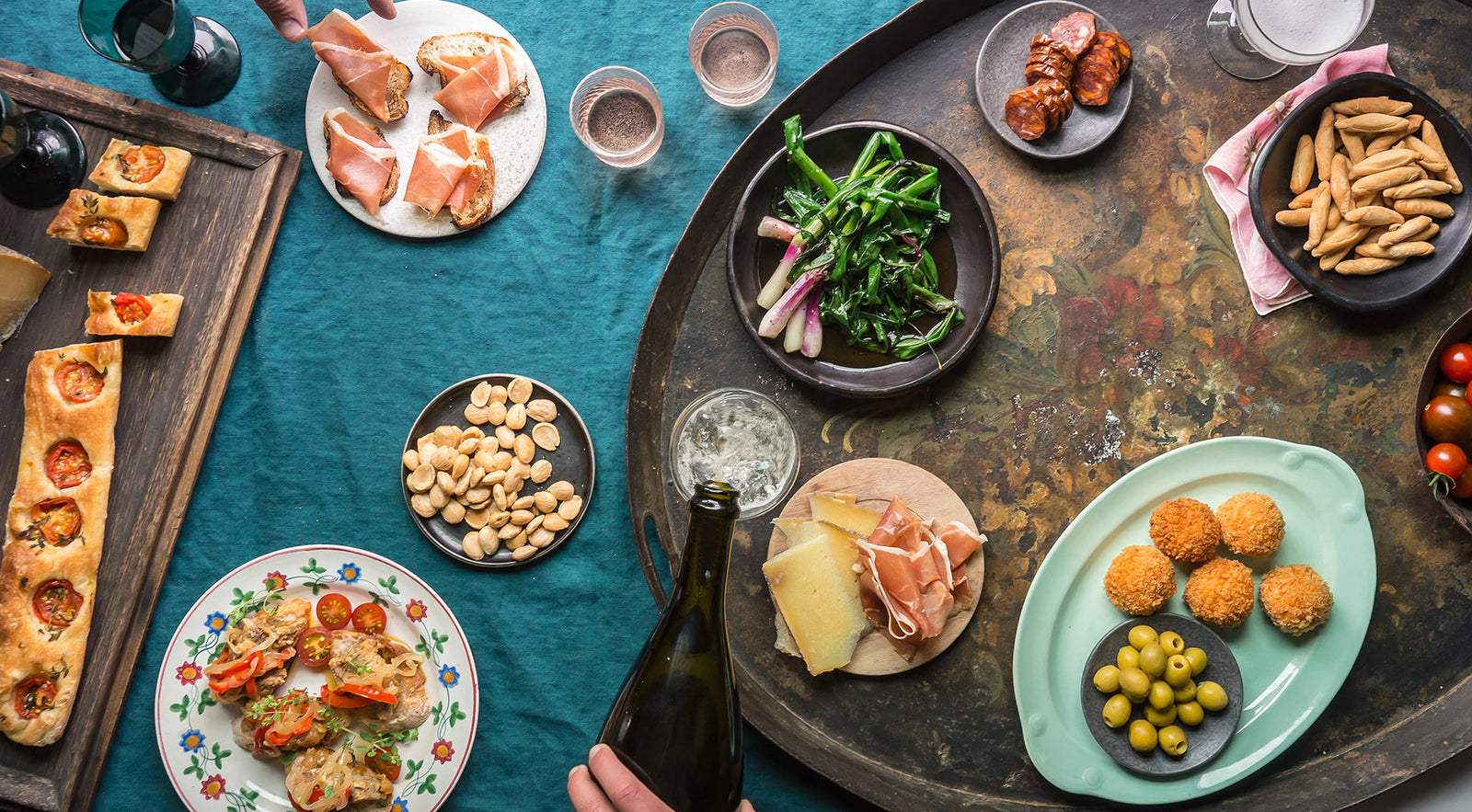How To: Pair Wine & Food
Wine and food are two sides of the same coin; they are meant to be enjoyed together. And although you can always pop open any bottle to enjoy with your meals, if you want to do it right, you must find the right wine for the food.
A wine pairing makes both the food and the wine taste better. All the distinct types of wine have an affinity to different food, making every food and wine pairing an adventure!
What wine pairs well with seafood? How to pair wine and cheese? How does pairing wine work? Here are all the answers. This is our guide to food and wine pairings. Once you learn a few tricks and strategies, you’ll be pairing food and wine like a pro. We see delicious wine dinners in your future! Let’s get started.
Flavours vs Aroma
Before discussing food and wine pairings, we must talk about something fundamental. The difference between flavour and aroma. This might sound obvious, but it isn’t.
When you have a scoop of chocolate ice cream, you say it tastes like chocolate. But that’s not all that accurate. The ice cream smells like chocolate, and you perceive these scents either with your nose or retro-nasally. There are only a few perceivable flavours out there, sweet, salty, bitter, acidic and umami (savoury deliciousness). There are thousands of aromas, though.
This is particularly important with wine. Wine can have aromas redolent of red or black fruit, or apples or pears, citrus or tropical fruit. You might also detect aromas of tobacco, leather, damp earth, cinnamon, vanilla and many others. On the palate, wine can only be sweet, acidic and sometimes a bit bitter — that’s it.
Having made this subtle but meaningful distinction, we can now talk about pairing food and wine based on flavours and aroma.
Grapes and their Personalities
There are hundreds, if not thousands, of different wine grapes. And although the place where they grow, or their terroir, plays a role in the wine’s flavour and aroma, every grape has its signature. Every grape has a unique personality, and we can use it to our advantage at the table.
Wines made with Cabernet Sauvignon have distinct red and black fruit aromas, often followed by oak spices and a unique scent reminiscent of bell peppers. With this in mind, one can make any dish more compatible with Cabernet by adding a side of roasted bell peppers to the plate.
Syrah smells like freshly cracked black pepper, which pairs well with peppery food. Mushroom scents in Pinot Noir can make it beautifully compatible with mushroom sauces. Most grapes have a telltale, and they can be the key to unlocking exciting wine pairings.
Strategy One: Find Common Ground
The first food and wine pairing strategy to consider is finding common ground. As explained above, wines smell and taste differently depending on the grapes used, just like food tastes differently depending on its ingredients.
If you were to pair a thick, fatty steak, you’re better off finding robust red wines. Still, if the wine has bell pepper scents (like those made with Cabernet), you can serve your steak with roasted vegetables or peppers.
A pinch of ground cinnamon to your creamy sauces can make them much more compatible with an oak-aged Chardonnay, which often shows brown spices on the background.
A fish fillet will shine with a crisp white wine, but if the wine is citrusy, squirt lemon juice on your fish. Find common ground between your wine and food; if you can’t find it, make it happen.
Acidity Matters
One of the most important things to consider when pairing food and wine is acidity. Wine without acidity tastes flabby. On the other hand, medium to high acidity levels can make the wine more versatile at the table.
However, there’s a rule: the wine must always be more acidic than the food. That’s why salads with a vinaigrette dressing or lemony ceviche are so hard to pair with wine. If the food is more acidic than the wine, your drink will taste dull.
On the plus side, acidity in the wine will freshen your palate between bites, as it will make you salivate. Just like a splash of lemon juice or vinegar can lift food, a tart wine can make your dining experience more enjoyable.
Pro tip: Wines from cold regions or high altitudes have more acidity than wines grown in warm areas or low elevation regions.
Sweetness Is Handy
Almost all wines are dry, especially when talking about food-compatible wines. Still, many sweet and semi-sweet wines out there are not necessarily dessert wines. Late harvest wines and other specialities have just enough residual sugar to taste sweet without being overwhelming.
Sugar balances the acidity in food and tames the heat in hot peppers. Spicy food like curries, stir-fries or fajitas is more enjoyable with a semi-sweet wine. Typical wine grapes that make wine with residual sugar include Gewürztraminer, Riesling, Moscato and others.
Pro tip: When pairing dessert wines with desserts, make sure the wine is always sweeter than the food. Overly sweet desserts will make the wine taste too tart or flabby.
Sweet red wines also exist. Red wines made with Zinfandel, Ripasso and Passito wines from Italy and, to some extent, Australian Shiraz have noticeable residual sugar while still being compatible with main courses.
Alcohol Strength, What About It?
Wines can have as little as 7% alcohol by volume or 17% ABV. And although alcohol is not a significant factor when pairing your dinner, you should know a few things. Alcohol in wine can make spicy and hot food taste more astringent and aggressive, so if you’re not all that into hot peppers, choose wine with lower alcohol by volume.
Pro Tip: The more sugar in the grapes, the more alcoholic the wine. And since warm weather causes grapes to ripen, wines from warm wine regions are more alcoholic than those with colder climates.
Chardonnay from Chablis, one of the northernmost wine regions in France, will have low alcohol compared to a Chardonnay from the sunny Napa Valley. Again, for wine and food pairings, alcohol is not the most crucial factor, but it matters.
Tannins in Red Wines
Tannins are plant-based molecules found in all plant matter, including grape stems and skins, and they’re prevalent in red grapes. Tannins in red grapes find their way into wine, and they cause a drying sensation on the palate. Tannic wines play a unique role in wine and food pairings — tannins bind with fat and protein molecules, rounding them up.
Do you know what’s fatty and packed with proteins? Red meat, and that’s why a thick, decadent steak pairs best with tannic wines like Cabernet Sauvignon.
Tannic grapes include Cabernet Sauvignon, Cabernet Franc, Shiraz, Tempranillo, Nebbiolo, Sangiovese and Malbec. These are all excellent alternatives for grilling parties.
Pro tip: The cooking method is often more important than the food itself when choosing the right wine. Char-grilled meat is smokier than pan-fried steaks. This is a fantastic opportunity to enhance your pairings by combining smoky food with smoky wine.
Strategy Two: Complementary Pairings
When pairing food and wine, the name of the game is finding complementary flavours. Rich and creamy wines like oaked Chardonnay pair best with rich and creamy fish like salmon. Light-bodied white wine like Sauvignon Blanc is best for plain white fish.
Complement wine and food by perceived weight, body, richness and flavour intensity. By matching a bold wine with bold food and light meals with milder wines, you ensure they go well together — none is more overpowering than the other.
Popular complementary pairings include white meat and oily fish with Chardonnay, steaks with Cabernet, raw seafood with Sauvignon and aromatic curries with aromatic white wines like Gewürztraminer.
There’s a lot of interpretation in complementary pairings — do your best to find congruence in your selection. What’s similar in the wine and food?
Strategy Three: Contrasting Pairings
Complimentary pairings are not always easy to achieve, and you might not always have the luxury of selecting the wine or the food for a pairing; think of Sommeliers trying to find the right wine for your choice of dinner.
Contrasting pairings are more effective and easier to do. In this case, the most efficient way of contrasting food with wine is using wine with high acidity. In a complementary pairing, you could pair a steak with red wine; with contrasting pairings, you could pair the same steak with tart sparkling wine.
In contrast pairings, the idea is to let the wine’s acidity cut through the fat in rich meals. Based on this wine pairing strategy, we can safely say sparkling wines pair well with everything — simply because they’re the most acidic wines in the world.
Get Creative
Pairing food and wine can be challenging, but this is no hard science. Even your most successful combinations might not be attractive to everyone. After all, we all like different things.
Wine pairings are all about experimentation, which makes them exciting! Although the strategies and tips above can help you find the right wine for your dinner, there’s nothing wrong with following your heart and enjoying your favourite food with the wines you love.
The best part about pairing wine with food is that it gives you yet another excuse to get together with your loved ones. Wine is meant to be shared around the table with friends and family. Sometimes, people are the best pairing for wine and food.
If you want to get better at pairing food and wine, eat with wine often. Practice makes perfect.
